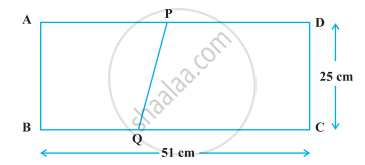Advertisements
Advertisements
Question
The area of a triangle with vertices (a, b + c), (b, c + a) and (c, a + b) is ______.
Options
(a + b + c)2
0
a + b + c
abc
Solution
The area of a triangle with vertices (a, b + c), (b, c + a) and (c, a + b) is 0.
Explanation:
Let the vertices of a triangle are, A ≡ (x1, y1) ≡ (a, b + c)
B ≡ (x2, y2) ≡ (b, c + a) and C = (x3, y3) ≡ (c, a + b)
∵ Area of ΔABC = Δ = `1/2[x_1(y_2 - y_3) + x_2(y_3 - y_1) + x_3(y_1 - y_2)]`
∴ Δ = `1/2[a(c + a - a - b) + b(a + b - b - c) + c(b + c - c - a)]`
= `1/2[a(c - b) + b(a - c) + c(b - a)]`
= `1/2(ac - ab + ab - bc + bc - ac)`
= `1/2(0)`
= 0
Hence, the required area of triangle is 0.
APPEARS IN
RELATED QUESTIONS
Find the area of the quadrilateral ABCD whose vertices are respectively A(1, 1), B(7, –3), C(12, 2) and D(7, 21).
Find values of k if area of triangle is 4 square units and vertices are (k, 0), (4, 0), (0, 2)
Prove that the points (2a, 4a), (2a, 6a) and `(2a + sqrt3a, 5a)` are the vertices of an equilateral triangle.
Find the angle subtended at the origin by the line segment whose end points are (0, 100) and (10, 0).
Find the area of a triangle whose sides are respectively 150 cm, 120 cm and 200 cm ?
Find the value of y for which the points A(-3, 9), B(2,y) and C(4,-5) are collinear.
If the area of triangle ABC formed by A(x, y), B(1, 2) and C(2, 1) is 6 square units, then prove that x + y = 15 ?
Find the area of the triangle whose vertices are (–8, 4), (–6, 6) and (–3, 9).
Find the values of k if the points A(k + 1, 2k), B(3k, 2k + 3) and C(5k – 1, 5k) are collinear.
The dimensions of a rectangle ABCD are 51 cm × 25 cm. A trapezium PQCD with its parallel sides QC and PD in the ratio 9 : 8, is cut off from the rectangle as shown in the following figure. If the area of the trapezium PQCD is `5/6` th part of the area of the rectangle, find the lengths QC and PD.

